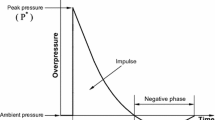Abstract
On the basis of numerical modeling specific features of shock wave reflections were analyzed. It was found, that after diaphragm rupture self-modeling pressure and velocity distributions nearby the shock front establish. But in some special cases the temperature behind the shock front can rise. This peculiarity should be taken into account when performing experiments with high reactive gaseous mixtures. The temperature on the shock front and the velocity gradient behind it are uniform in the case of strong blast wave reflections. This effect is observed in the zone with an elevated temperature profile behind the incident blast wave. The reflected triangular waves conserve a quasi-self-modeling character by pressure. Typical experiments were carried out to verify the theoretical predictions. The effects of reflected wave acceleration in the case of triangular waves and the self-similar character of the pressure profiles were observed.
Similar content being viewed by others
References
Borisov AA, Gelfand BE, Tiraofeev EI, Tsyganov SA, Khomik SV (1983) Selfignition of Atomized Fuel in Gas Medium. In: Bowen TR, Manson N, Oppenheim AK, Soloukhin RI (eds) Flames, Lasers and Reactive Systems, Vol 88, Progress in Astronautics and Aeronautics: AIAA Inc. N.Y., pp. 239–251.
Gaydon AG, Hurle IR (1963) The Shock Tube in High-Temperature Chemical Physics. Chapman and Hall Ltd, London.
Gelfand BE, Gubin SA, Kogarko SI (1973) Droplet Breakup behind Shock Waves with Triangular Pressure Profile. Izv. USSR Ac. Sci., Mech. of Fluids and Gases, No. 5, p. 54.
Gelfand BE, Polenov AN, Frolov SM, Tsyganov SA (1986) The Possibility of Applying Shock Tube Technique for Investigation of Explosion Processes. Khim. Fizika, v.5, No.1, pp. 121–128.
Kauffman CW, Nicholls JA, et al. (1983) Techn. report UM-016968, Michigan, 74p.
Kuznetsov VV, Nakoriakov VE, Pokusaev BG, Shraiber IR (1977) Shock Waves in a Gas-Liquid Medium. Acoustic Journal, v.23, No. 2, p. 273.
Rakhmatullin KhA, Semenov SS (1962) Eds. Shock Tubes. I Inostr.Lit., 699 p.
Richtmyer RD, Morton KW (1972) Finite Difference Methods for Boundary Problems. Í.: Íir, p.418. (Trans, from Engl.)
Sysoev NN, Shugaev FV (1987) Shock waves in gases and condensed media. Moscow University Publ.
Wierzba AS, Kauffman CW, Nicholls JA (1974) Ignition of Partially Shattered Liquid Fuel Drops in Reflected Shock Enviroment. Comb. Sci. Technol., 9:233–245.
Yu H, Esser B, Lenartz M, Grönig H (1992) Gaseous detonation driver for a shock tunnel. Shock Waves, 3:245–254.
Author information
Authors and Affiliations
Additional information
This article was processed using Springer-Verlag TEX Shock Waves macro package 1.0 and the AMS fonts, developed by the American Mathematical Society.
Rights and permissions
About this article
Cite this article
Gelfand, B.E., Bartenev, A.M., Medvedev, S.P. et al. Specific features of incident and reflected blast waves. Shock Waves 4, 137–143 (1994). https://doi.org/10.1007/BF01417429
Received:
Accepted:
Issue Date:
DOI: https://doi.org/10.1007/BF01417429




